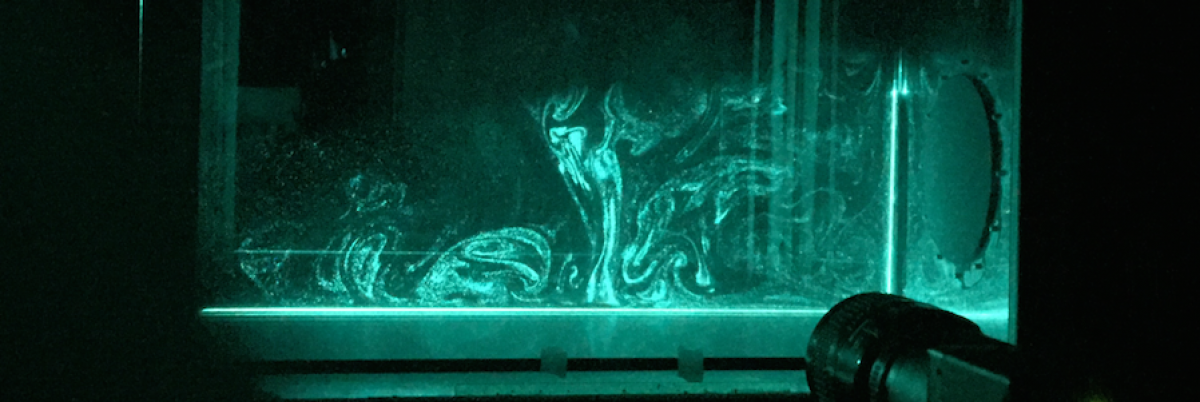This page is perpetually under construction (and, admittedly, the least-updated part of the site, sorry!), but we hope it will give you a brief glimpse into the environmental fluid mechanics and hydraulics research happening in the JET lab! Hope to have some images and videos here soon. Check out Prof. Johnson’s twitter @blairajohnson for the latest videos of lab happenings and occasional #FlumeFriday contributions.
Present work at the JETLAB:
Erosion of a sharp density interface by homogeneous isotropic turbulence
It has been observed that desalination discharges in the Gulf of Mexico do not fully mix into the ambient waters, causing dense saline layers to rest at the bed. This can have significant ecological impacts, though such consequences could be avoided by limiting the salinity of the discharges and/or improving outfall conditions to encourage adequate mixing. The present project is looking at the fundamental entrainment mechanisms across a density interface due to homogeneous isotropic turbulence in absence of mean shear, and ongoing work will address how density gradients can be eroded or sharpened by ambient turbulent flow conditions. Future work in this area may include numerical modeling and/or field work in the Gulf of Mexico. This is part of an NSF CAREER award – we’ll post updates as the project evolves to its later stages!
Correlating entrainment mechanisms and turbulence in a buoyant plume to large-scale visual structures
Motivated by volcanic eruptions where buoyant plumes transport particles into the atmosphere, we will be using optical measurements to explore turbulent entrainment of particulate matter into the ambient. This project will also be focused on improving measurement techniques and expanding capabilities of field measurements where instrumentation is limited. This project is funded by NSF CBET, in collaboration with Dr. Alexis Kaminski (UC Berkeley) for numerical modeling.
Enhancement of Ice Melting Rates via Homogeneous Isotropic Turbulence
Recent field studies have shown that glaciers are melting 10-100x faster than traditional models predict, and it is suspect that turbulence is driving this rapid melting, due to the constant stirring of meltwater with adjacent warmer waters (i.e. meltwater plumes, discharge plumes, Atlantic water, etc). To parameterize the distinct contributions to melting from temperature and turbulence, this project studies ice melting rates in a tank designed to generate homogeneous isotropic facility in an idealized fundamental study.
Fluidization of a sediment bed due to homogeneous isotropic turbulence
(details forthcoming)
Investigating the mechanism of pressure flushing
When dams are constructed, sediment that would otherwise flow downstream is obstructed by the dam and accumulates in the reservoir, thus reducing the storage capacity of the reservoir. It can be difficult and expensive to remove this sediment via dredging, and so we are investigating sediment removal using the pressure flushing technique.
Development of concrete median barrier for flood-prone areas
(details forthcoming)
In-Situ Determination of Volumetric Flow Rate via Surface Imaging Techniques
(details forthcoming)
Prof. Johnson’s prior work:
Turbulent boundary layers and sediment suspension in absence of mean shear
Johnson, B.A. and Cowen, E.A. “Turbulent boundary layers absent mean shear.” Journal of Fluid Mechanics. 2018. https://doi.org/10.1017/jfm.2017.742
Johnson, B.A. and Cowen, E.A. “Sediment suspension and bed morphology in a mean shear free turbulent boundary layer.” Journal of Fluid Mechanics. 2020. https://doi.org/10.1017/jfm.2020.222
Gas and particle motions in a rapidly decompressed flow
Johnson, B.A., Ding, L., Zunino, H.A., Adrian, R.J., and Clarke, A.B. “Velocity Measurements of Gas Escaping a Particle Bed during Shock-driven Expansion.” Accepted at Experiments in Fluids. https://doi.org/10.1007/s00348-020-03069-4
